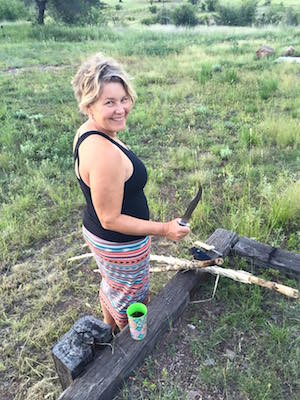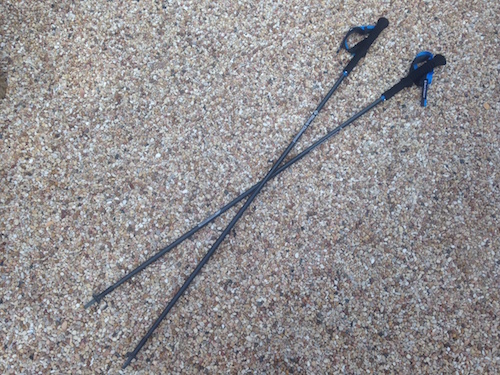As preparation for my upcoming Grand Canyon trip, I recently purchased something I never thought I’d own — trekking poles.
Trail vs. Road Running

For years now, I’ve been running on trails. My goal is always to move swiftly through the woods, running whatever the trail allows (meaning, sometimes I go fast and other times, I have to walk). I like to travel light, packing my stuff economically to ensure the least amount of weight to carry and that I leave no trace of my trip.
However economical I might try to be, trail running involves more gear than road running. I had to get a hydration pack to carry the water needed for hours without access to faucets or stores. A headlamp became a necessity. And when I took on 100K and 100-mile races, I invested in waterproof bags to drop at aid stations.
Road running, on the other hand, requires almost nothing: shoes, shorts, bra, and (sometimes) a handheld water bottle. Taking it off-road has meant more stuff, and a different mindset to go with it. The amount of planning required in sport seems to rise proportionately with the amount of gear needed (let’s not even talk triathlon).
Transitioning to Hiking
This summer, I spent a week at the Davis Mountain Fitness & Training Camp. The Davis Mountains, Texas’ only system completely contained within state borders, ranges in elevation from 3,500 to 8,332 feet, and so I opted to go on many of the guided hikes — my favorite was a climb to Baldy Peak, the highest tip of Mt. Livermore (the tallest peak in the range, the 4th highest in Texas).
One of the first hikes I took was a bushwhack to the top of Mt. Arabella. Our guide insisted that I carry a walking stick. I was skeptical — why in the world would I need such a thing? No aid was necessary when I ran to the top of Pikes Peak (14,115 feet) or Mosquito Pass (13,185 feet). But “Sargent” Shramm made all of us carry a walking stick, and by God, I was glad I followed orders; I needed it. With no path to follow and a steep, rocky incline, that staff was instrumental in balancing and anchoring while I searched for footing. My legs were shaking when we finished the trip.

And so when Sgt. Shramm said a walking stick was needed for the hike up Mt. Livermore to Baldy Peak, I carried one. While it was nice to have, there were many sections where I longed to drop the big wooden staff and take off running. Several people brought their own trekking poles, which appeared to be more convenient, but I observed some user error (one hiker stabbed my heels repeatedly with her poles until I made a point to avoid her reach).
Though the walking stick came in handy at camp, I wasn’t convinced I’d need that assistance on my Grand Canyon trek. After all, I know quite a few trail runners who’ve made the rim-to-rim (and rim-to-rim-to-rim) trip that didn’t carry poles. And then I heard a trail runner I respect say her one regret on making the canyon crossing was that she didn’t utilize poles. Hmmmm….
Friends had planned a weekend run at River Place Nature Trail, sometimes referred to by Austin’s trail runners as “Stairway to Hell.” It’s a point-to-point 3-mile trail through a canyon, with some 1,000 feet of vertical gain, mostly made via stairs — up and down, irregularly sized, steep stairs. When the park sign says to allow 3 hours for the out-and-back trip (and my fit friends advised planning for 2:15), I knew there wouldn’t be any running. It seemed a perfect place to test drive some trekking poles.
What to Buy in Trekking Poles

Cheryl Strayed wasn’t exaggerating in Wild: From Lost to Found on the Pacific Crest Trail when she raved about REI’s return policy (remember her boots?). It’s one of the primary reasons I’ve been a co-op member since pre-2000 (that, and my awesome dividend check). So naturally, I decided to purchase poles there; if for some reason they didn’t work out, I’d have a no-hassle return. I’d also get excellent help from staff on selecting the right pair.
6 Things to Consider:
- weight — less is more, and you pay for it. Poles made of carbon weigh less than aluminum, and ultralight poles will weigh less than a pound.
- size — this is relative to your height. Also, you’ll need to decide if you want adjustable poles (these could be used by more than one person).
- construction — poles fold into two or three segments. The methods for locking these segments into place vary (push buttons, twist locks, or clamps, sometimes in combination).
- grips — materials used in handgrips will have different feels. This will be subjective. If you have smaller hands, then women’s poles will tend to fit better.
- bells & whistles — just like any leisure sports gear, these are all kinds of additional features: shock absorbing poles, poles with camera mounts, varieties of tips.
- good to know — they are sold in pairs. Poles are left- and right-handed. Prices range $60 to $160, depending on type and materials used.
After consulting with the salesman, I opted for Black Diamond’s Distance Carbon Z. At 120cm, they fit not-quite-5′-4″-me perfectly. Made of carbon fiber, the two weigh next to nothing (a total of 10 ounces). The foam grips feel nice in my hands. I loved the three-part breakdown, which operates like my tent — a button is depressed, the segments pull apart along a Kevlar cord, and the poles quickly fold; putting them back together is done in one fluid, locking motion. They were on the high end ($160) but I had $78 in REI dividends (score!), so I bit the bullet.
What I Learned Using My Trekking Poles

We started out in the dark, and I opted to go without poles for the first 6 miles. I caught myself pushing on my thighs a couple of times when steps were high. Because placement was irregular and awkward, I hesitated often over whether to take one or two steps between stairs. The out-and-back took every minute of the 2:15 my friends had promised.
I used my new poles for the next 10 miles. There was a learning curve as to technique (what did I do during the flats? alternate poles or move both together when climbing? how to handle eating and drinking while carrying these things?) and that irritated me at first. However, I quickly discovered the awkward downhills went much smoother with another balancing point, and the poles eliminated the need for the pushing off I’d done when climbing on my first loop.
The longer I used them, the more comfortable I got with passing people, finding an effortless rhythm, navigating straps while transitioning hands. I had intended to let a friend try one out, but I realized I wanted both on those endless uphills, so I stiffed her on that test (sorry).
The cons? I wondered at what point I would trip myself (it’s bound to happen sometime). Because my skin wasn’t used to the grips, I developed a few small hot points on my thumbs. Eating and drinking was a bit tricky, and the logistics involved threw me off my nutrition schedule at first. I’ve still got to figure out how they’ll fit in my pack when I want to run, and I suspect that proper stowage will cost me a few minutes in rearranging my gear.
The bottom line: I’m keeping the trekking poles. They saved my lower back, and my legs are less trashed than they would have been without using poles. Now all I’ve got to do is play with how best to carry them when not in use. That, and figure out if I can put poles in my carry-on luggage.



Awesome! When I was in Slovenia all of the hikers had trekking poles and my swim guide told us we should get some if we did any hiking in the region (sadly I twisted my ankle and that ended that!).
Also funny: You are about to go to Grand Canyon to hike, and I am contemplating a trip to swim in Lake Powell! 😀 Maybe you can wave to me from up top.
Another great post! And after your review of those poles, now I know what my mountain hike loving Dad is getting for Christmas (shhh, don\’t tell him). He has poles, but they old and clunky. The ones you describe sound delightful!
I have been living in a parallel universe and did not know you had a blog. My loss! I enjoyed this and look forward to more posts in the future.
glad to see this; I\’ve been considering poles for quite awhile. My only concern is there a loss of that wonderful sense of freedom that comes on the trails? not sure if I\’m explaining that clearly…but if the poles can blend into the fluidity of the movement I\’m all for trying them; but if they become a distraction I don\’t think I\’d stick with them.
You know, Kim, I worried about this as well. Several of my friends had wonderful hydration packs that had built-in straps to neatly carry poles. My pack didn\’t. Carrying the poles when I wasn\’t using them was a distraction, and it was a bit awkward (even though they\’re so light). I wouldn\’t use poles on just any trail–only on something like the Grand Canyon, where I knew I\’d use them for the majority of the time.
About interfering with fluidity of motion…I get you. There\’s a little bit of a learning curb to find the right swing and movement, and then they\’re really second nature. That wasn\’t much of a problem for me.
They\’re a great tool to have in your pile of trail stuff, to be pulled out for certain climb-heavy routes. I have not used mine since the Grand Canyon trip.
Just wanted to update: I did take my trekking poles to a recent race in North Carolina, and you can read about that experience in my post, \”DFL, DNF or DIM (Does It Matter?) at the Leatherwood Ultra\” (https://leahruns100.com/2016/05/03/dfl-dnf-or-dim-does-it-matter-at-the-leatherwood-ultra/). I plan to work more thru hiking into my schedule, so I\’ll be looking for a backpack that will allow me to easily carry my poles on the next adventure.
Thank you, I needed information to buy trekking poles for my first ultra trail run but I had no idea where to start. I always thought I didn\’t want to use poles but now I\’m training for a 50K in the dunes and after the 30K edition last time I realized I do want to use poles.
Glad this was helpful. I used my poles in April in a very hilly 50K (you can read about that adventure in \”DFL, DNF, or DIM (Does It Matter?) at the Leatherwood Ultra\” and most recently, while at Davis Mountain Fitness & Training Camp in West Texas (\”So You\’re Hiking in West Texas….\”
Let me know how your 50K in the dunes goes!